Crepe Myrtle isn’t just another flowering tree – it’s a landscaping powerhouse. With vivid summer blooms, sculptural bark, and impressive adaptability, it can turn any outdoor space into a visual highlight. From compact patio varieties to full-size trees that anchor entire gardens, its range is unmatched.
Choosing the right type and knowing how to grow it well makes all the difference. This article breaks down the core species, highlights stand-out cultivars, and shows how to get the best out of each one – visually and practically.
Key Takeaways:
- Crepe Myrtle is a flowering tree known for its vivid blooms, colorful bark, and striking fall leaves.
- It comes in many sizes – from compact shrubs for containers to tall trees for shade and structure.
- Different types vary in color, growth habit, cold tolerance, and blooming time.
- Choosing the right variety depends on your space, climate, and design goals.
- With proper care – sunlight, pruning, and good airflow, Crepe Myrtles thrive and bloom year after year.
Table of Contents
About Crepe Myrtle
Crepe Myrtle (Lagerstroemia) is a widely planted ornamental tree known for its colorful blooms, smooth peeling bark, and minimal maintenance needs. From small urban gardens to large landscapes, it adapts easily and delivers beauty from spring through fall.
Why Crepe Myrtle Is Popular in Gardens
Crepe Myrtle stands out for its long bloom season, colorful exfoliating bark, and vibrant fall foliage – all packed into a low-maintenance tree or shrub. With varieties ranging from small container-friendly types to 30-foot trees, it’s one of the most adaptable plants in American landscaping.
It’s often used as a focal point, flowering screen, or part of a layered border. The ability to provide visual interest in every season makes it a go-to choice for both home gardens and public spaces.
Where Crepe Myrtle Comes From
Originally native to China, Korea, Japan, and parts of India, Crepe Myrtle has a long horticultural history. It was introduced to the United States in the late 1700s and quickly became a favorite in the South for its ability to thrive in heat and bloom for months.
Modern hybrids now extend its range beyond warm climates, making Crepe Myrtle accessible across USDA zones 6 through 9. Its adaptability and ornamental appeal have turned it from an imported novelty into a landscape essential.
Types of Crepe Myrtle – Indica, Fauriei, and Hybrids
Not all Crepe Myrtles are created equal. While they share the same family traits – vivid blooms, attractive bark, and seasonal interest, there are key differences between the main types. Understanding how each group behaves in terms of size, hardiness, bloom time, and care requirements will help you choose the right one for your garden.
Lagerstroemia indica (Indian Crepe Myrtle)
The most common type in U.S. landscapes, Lagerstroemia indica is known for its long-lasting flowers, colorful bark, and compact size. It comes in shades of red, pink, lavender, and white, often blooming from early summer into fall.
This variety typically grows between 10 and 20 feet tall, though dwarf cultivars exist. It thrives in full sun, tolerates drought once established, and performs best in USDA zones 7–9. Thanks to its manageable size and reliable flowering, it’s widely used in residential gardens, parking lots, and city landscapes.
Popular cultivars include:
- ‘Dynamite’ – Brilliant red flowers, upright habit
- ‘Muskogee’ – Soft lavender blooms, fast-growing
- ‘Natchez’ – White flowers, attractive cinnamon bark, often used as a small tree
Lagerstroemia fauriei (Japanese Crepe Myrtle)
Native to Japan, Lagerstroemia fauriei stands out for its graceful form, larger mature size, and strong resistance to pests and diseases. It typically grows taller than indica types, often reaching 20 to 30 feet, and has a more upright, vase-like shape.
Its bark is one of its key features: smooth, peeling layers reveal striking tones of gray, cinnamon, and tan. The flowers appear in white or soft pink shades and may be less dense than those of indica, but they contrast beautifully with the dark green, glossy foliage, which turns fiery red or orange in fall.
Fauriei types are excellent choices for shade trees, specimen planting, or where height and elegance are needed. They perform best in full sun, with well-draining soil, and are often more tolerant of cooler climates – thriving in USDA zones 6 through 9.
Notable cultivars:
- ‘Fantasy’ – Vigorous grower with white blooms, great for tall focal points
- ‘Acoma’ – Semi-dwarf with cascading branches and soft white flowers
- ‘Basham’s Party Pink’ – Tall hybrid-like selection with excellent bark and long bloom time
Hybrid Varieties – Best of Both Worlds
Hybrid Crepe Myrtles combine the flower density and color range of Lagerstroemia indica with the height, bark quality, and disease resistance of Lagerstroemia fauriei. These crosses offer improved cold tolerance, longer bloom periods, and lower maintenance – ideal for gardeners who want performance without compromise.
Hybrids are available in various sizes, from compact shrubs to 25-foot trees. Many feature dramatic bark contrast, extended flowering from summer to early fall, and strong resistance to powdery mildew – a common issue in older indica types.
Top hybrid cultivars include:
- ‘Natchez’ – Large white blooms, strong cinnamon bark, fast growth
- ‘Tuscarora’ – Coral-pink flowers, upright habit, heat tolerant
- ‘Biloxi’ – Soft pink blooms, exfoliating bark, good in humid climates
These varieties are especially popular in transitional climate zones or for gardeners who want visual impact and resilience in a single tree.
Visual Appeal – Flowers, Bark, and Fall Color
Crepe Myrtle is one of the few ornamental trees that delivers visual impact in every season. From bold blooms in summer to colorful bark and vivid autumn foliage, it draws attention long after other plants fade.
Blooms that Last
Crepe Myrtle flowers range from deep red and purple to white, lavender, and coral pink. Some even produce bi-color clusters. Most varieties bloom from early summer into fall, with a few reblooming after midsummer pruning.
Bark with Texture
As the tree matures, its bark exfoliates – peeling to reveal smooth layers in cinnamon, tan, or soft gray. This creates year-round visual interest, especially in winter when the canopy is bare.
Leaves That Light Up Fall
Foliage is typically glossy and oval-shaped. In autumn, it turns dramatic shades of red, orange, or purple – adding another layer of color before winter sets in.
Whether you want long blooms, four-season color, or standout bark, Crepe Myrtle delivers all three in a single plant.

How to Choose the Right Crepe Myrtle
Not every Crepe Myrtle fits every space – or purpose. Choosing the right one depends on three things: size, style, and growing conditions.
Match the Mature Size to Your Space
Crepe Myrtles range from 3-foot dwarf shrubs to 30-foot shade trees. If you’re planting near walkways, fences, or windows, smaller varieties are ideal. For privacy screens or focal points, larger types offer more impact.
Think in Design Terms
Beyond size, color matters. Bold red or purple flowers make a statement. Soft pink or white varieties are better for blended, layered borders. Also consider bark texture and fall color – both add depth to your garden’s visual rhythm.
Don’t Ignore Climate and Soil
Most Crepe Myrtles thrive in USDA zones 6–9, but not all tolerate cold equally. Hybrid types usually offer better disease resistance and hardiness. Ensure the site has full sun and well-draining soil. If your soil is heavy or compacted, amend it before planting.
Tip: If you’re unsure, start with a mid-sized variety (around 10–15 feet) with neutral bloom color. It’s easier to work into future design changes.
How to Grow and Maintain Crepe Myrtle
Crepe Myrtles are easy to grow – but they perform best when planted right and maintained with intention. From soil prep to pruning, small decisions make a big difference in bloom quality and plant health.
Planting Location and Soil
Choose a site with full sun – at least 6 hours daily. The soil should drain well. If it’s clay-heavy, loosen and amend it with compost or sand. Dig a hole slightly wider than the root ball and set the plant at ground level, not deeper. Water deeply after planting and mulch the area, leaving space around the trunk.
Watering and Fertilizing
Water regularly during the first season to help roots establish. Once mature, Crepe Myrtles are drought-tolerant but still benefit from deep watering during prolonged dry spells.
Use a slow-release fertilizer in early spring. Avoid high-nitrogen products – they stimulate leaf growth at the expense of flowers.
Timing Tip: In most regions, fertilize once in early spring, just as buds swell. Avoid feeding after midsummer – it can trigger weak, late-season growth.
Pruning Smart, Not Hard
Prune in late winter or early spring before new growth appears. Remove dead, damaged, or crossing branches. Skip the practice of “topping” (cutting back main trunks), which leads to weak regrowth and poor structure.
Pest and Disease Management
Crepe Myrtles are generally resilient but can suffer from aphids, scale, spider mites, and powdery mildew. Encourage airflow through proper spacing and pruning. At the first sign of pests, use insecticidal soap or horticultural oil. For fungal issues, apply fungicide only when needed – and avoid wetting the leaves from overhead.
Tip: Overwatering and overfertilizing are the two fastest ways to reduce blooming. Keep inputs moderate and consistent.
Pests, Diseases, and Common Issues
Crepe Myrtles are known for their resilience – but like any plant, they can run into trouble. Recognizing early signs and responding with the right strategy keeps problems small and manageable.
Powdery Mildew
This fungal disease appears as a white, powder-like coating on leaves and buds. It slows growth and reduces blooms. Prevent it with proper spacing, airflow, and by avoiding overhead watering. Prune crowded areas, and use fungicide only if symptoms persist.
Aphids, Scales, and Mites
These sap-sucking insects weaken plants and leave sticky residue that attracts mold. If you see curled leaves, stunted growth, or honeydew, inspect closely. Treat infestations with insecticidal soap, horticultural oil, or by encouraging beneficial insects like ladybugs.
Poor Growth or Lack of Blooms
If your Crepe Myrtle isn’t thriving, check light, soil, and pruning. Too much shade, poor drainage, or excessive nitrogen can limit flowering. Also avoid hard pruning (topping), which weakens the structure and delays bloom cycles.
Troubleshooting Examples
- Sticky leaves and black mold? Likely aphids or scale. Rinse with water and apply horticultural oil weekly until cleared.
- White film on new growth? Powdery mildew. Prune affected areas and spray with sulfur or potassium bicarbonate.
- No blooms this year? Check for excessive nitrogen fertilizer or hard pruning late in spring. Both delay or suppress flowering.
Most issues stem from one of three causes: lack of sunlight, poor air circulation, or over-care. Keep things simple – right plant, right place, minimal interference.

Environmental Benefits and Wildlife Value
Crepe Myrtles do more than beautify your space – they also contribute to a healthier garden ecosystem.
Pollinator-Friendly Blooms
The long-lasting flowers attract bees, butterflies, and other beneficial insects. This supports local biodiversity and helps with pollination of nearby fruits and vegetables.
Shelter and Food for Wildlife
Dense branching and foliage offer nesting sites and protection for small birds. The seeds and spent flowers provide seasonal food for insects and wildlife.
Low Resource Use
Once established, Crepe Myrtles require minimal watering and little fertilization. Their deep root systems improve soil structure and reduce erosion on slopes or in urban settings.
Drought-Friendly Landscaping: Crepe Myrtles work well in xeriscapes and water-wise gardens, especially in urban settings where water use is restricted.
Compatible with Sustainable Gardening
As low-maintenance, long-lived trees that need few chemical inputs, they’re a smart choice for environmentally conscious gardeners.
Conclusion – Embracing the Beauty of Crepe Myrtle
Crepe Myrtle offers a rare mix of beauty, adaptability, and long-term value. Whether you’re planting a compact variety in a container or establishing a full-size tree as a garden anchor, this species delivers visual payoff across seasons – with minimal upkeep.
Its vivid flowers, colorful bark, and fall foliage make it a standout. But its strength lies in more than looks: drought tolerance, resilience to pests, and support for pollinators all make Crepe Myrtle a smart, sustainable choice.
If you’re planning a garden that works as hard as it looks good, few plants offer more return with less effort.
FAQ
What is the best time to plant Crepe Myrtle?
Late winter to early spring is ideal, just before new growth starts. This gives roots time to establish before summer heat. Fall planting also works in warm climates with mild winters.
How big do Crepe Myrtles get?
Size varies by variety. Dwarf types grow 3–5 feet tall, while tree-form cultivars can reach 20–30 feet. Always check the mature height before planting near structures or walkways.
Why isn’t my Crepe Myrtle blooming?
Lack of sunlight, overfertilization (especially with nitrogen), and hard spring pruning can delay or prevent blooms. Ensure full sun and avoid aggressive topping.
Can I grow Crepe Myrtle in a pot?
Yes – choose a dwarf variety and use a large, well-draining container. Water consistently, and feed lightly in spring. Prune to maintain shape and remove spent flowers.
Are Crepe Myrtles invasive or messy?
They are non-invasive and low-maintenance. Some shedding of bark, flowers, and seedpods is natural but manageable. Choose a variety and placement that suits your tolerance for cleanup.










